The concept of a side-hustle is not at all new. It exists in every profession and vocation from lawn care and auto mechanics to accounting and education to coding and sales.
Across modern business history, there have always been entrepreneurial personalities who break away from their big company roots to take on side projects. Those projects grow into a side business, then that side business becomes a real company, then that company grows, then the process starts all over again.
What’s happened over the last couple of years is that technology has fueled the consumer’s desire for convenience and the entrepreneurial spirit’s quest for independence. What started with Uber and the implied promise of anyone earning extra side income evolved into entire industries of DIY businesses, a lot of which don’t even require you to quit your job or even leave your home.
That evolution is now creating startups that never would have existed as recently as five years ago. But what does it take to make the jump from side hustle to full blown startup? It’s not just the amount of “hustle,” that separates the two. You need a strategic plan.
Let’s talk about how to execute that plan.
Preparing your side hustle to be a startup
I’ve been a tech entrepreneur for over 20 years, sometimes teaming up with people who are smarter than me to make a run at a game-changing opportunity, other times building out a project from scratch just to solve a problem.
My most recent from-scratch project, Teaching Startup, is about distilling the experience of people like me to anyone who wants to start, run, and grow their own company. I wanted to make it universal, so an entrepreneur wouldn’t need to spend years creating a network of connections to get advice, and affordable, so an entrepreneur wouldn’t need to spend a fortune to get the answers they need.
I knew a couple of things about the project upfront:
- I would need to build this project organically in order to keep it affordable.
- I would need to rely on existing tools, namely eCommerce, newsletters, and no code, to put my money (or lack thereof) where my mouth was.
And so that’s where it started. To prove the viability of the Teaching Startup concept and to just get the thing out into the real world, I turned to Stripe, MailChimp, Zapier, and Bubble. I started with the free versions of all of those services, and within a couple of weeks, I had a prototype and a pilot. A few weeks later, I had paying customers.
But from my experience as an entrepreneur, there was also a third thing I knew. And it’s the reason I didn’t just go right to Substack, which would have glued the offerings of those four services together in a neat package so I could focus on the advice and answers.
I knew that if I went the Substack route, Teaching Startup would always remain a side hustle. And honestly that would have been fine — the chance to prove my thesis and solve a problem I can’t stand, even make some money on the side.
So I don’t need Teaching Startup to be a startup, but I need it to have that option, if just so its customers could learn from that option.
And so here’s what we’ve learned.
Establish your own customers
If someone hops in your car and pays you to drive them downtown, that person is not your customer, that person is Uber’s customer.
So make no mistake. If someone follows you on Medium, or signs up for your newsletter on Substack, or orders someone else’s product through your Shopify storefront, they are not your customer. Yet. Just because someone clicks and you get paid doesn’t mean your side hustle is a startup.
When I’m working on more mature startups, those that are a little further along than just a side project, one of my go-to moves is a referral or revenue share partnership with another, preferably larger, company. Either we sell through them or they sell through us or both. But no matter which way the customer finds the product, we spend plenty of time defining who “gets the customer.” And the answer isn’t automatically “both of us.”
A customer isn't your customer until you have the means and the permission to sell to them directly.
Permission is one thing, and companies like Uber make very sure that their drivers, whom they consider contractors, don’t have permission to contact the customer. This makes sense, since Uber is the entity actually creating the customer demand.
As an aside, I also believe that this is the disconnect on whether or not Uber drivers can be defined as contractors rather than employees. While neither side can exist without the other, the inherent value of Uber goes away if the drivers are employees, and the model doesn’t appear sustainable for the drivers if they’re considered contractors.
So the key is — don’t get caught in this trap. If you’re building your own business, you need to be neither a contractor nor an employee of another entity. If you are, no matter how much of the revenue you get to keep, it’s still the other entity’s revenue.
Once you have permission, the means to sell to a customer directly is a different story, but just as important. You’ll need a process to opt-in your own customers and collect their contact information. I’m a big fan of email lists to start (i.e. MailChimp), but eventually the goal is to get them into a system like HubSpot or Salesforce.
Create value beyond the hustle
Here’s the other reason I didn’t just plop Teaching Startup onto Substack. In my business plan, newsletters were only the beginning of the story.
In other words, my solution to the startup advice availability and affordability problem wasn’t simply a newsletter. In fact, some of the reasons why I “piggybacked” off of the newsletter concept can be applied to your own model:
- A newsletter could do the heavy lifting for the customer-facing end of the product. It’s quick, it’s somewhat flexible, and it provides a foundation for interaction. I wasn’t just sending emails, I was sending mini-websites (coders might call this an extremely thin client).
- A newsletter allowed me to get started quickly and prove the viability of the concept without writing a ton of code or creating a bunch of business rules.
- Paid newsletters are a bit trendy, which means most people understand how they work and what the value proposition is, so I wouldn’t have to reinvent the wheel and do much education. This means my customers could dive right into the value proposition.
But like I said, I want to add all sorts of features and functionality and fun to the Teaching Startup experience. I have grand plans, and Substack would have limited those plans, because their reason for being is to offer paid newsletters. In some sense, MailChimp and Zapier will end up limiting me in the same way.
So now that I’ve proven viability and pushed the business into the real world, I need to go back and turn my “paid newsletter business” into a startup that solves the problem I set out to solve. In my example, this is where no code comes in. It will let me offer my unique offering and value proposition to my own customers.
Control the money
Even when you own your own customers, if you don’t have control of the money, it’s still not your revenue. Using Uber as an example again, when you’re an Uber driver, the customer pays Uber, who then pays you. Almost all of that money is Uber’s revenue.
Going back to those revenue-sharing partnerships, if at all possible, the customer should be paying you, and you should be paying your partner. This goes beyond just the definition of who owns the revenue. It could have real-world financial implications for your business.
I hope you never have to deal with a partner who can’t or won’t pay you, but it happens. In fact, there are a ton of issues that can arise when your company doesn’t control the money, Here are just some of the problems I’ve dealt with first-hand:
- The partner insists on something like Net-90 days for you to get paid.
- The partner is consistently late paying you.
- The partner makes mistakes or otherwise fudges the numbers that are the basis for how much you should get paid.
- The partner insists on changing terms once you’re already underway.
- The partner disputes what makes a sale a sale.
- The partner screws up their end of the transaction after you’ve completed your end, and the customer refuses to pay.
Most of these can be avoided when the customer pays your company directly.
Invest time and money into your company
Growth doesn’t happen automatically and you can just run on autopilot and expect to scale.
One of the joys of the side hustle is that a lot of it can be automated these days. For example, there’s something very attractive about only having to worry about the content of the newsletter and letting Substack take care of everything else.
But this is also a side hustle trap, so to speak.
Even after you’ve broken away from a controlling entity, you can’t just spend 100% of your time and money serving your own customers with your own unique product. You have to invest a bunch of your time, and your profits, back into building the business.
The reasons it’s so hard to work for yourself isn’t usually the work itself, it’s everything else. Finding new customers, growing your company infrastructure, making sure you get paid, this all falls on you.
And that makes a nice segue into the final evolutionary step.
Make it so other people can do it
Your business will always be limited by how much time you have, whether you’re being paid by the hour or paid by the delivered product. So the final step in turning a side hustle into a full blown startup is hiring other people to do what you do.
That could mean hiring people to perform the service, or sell the product, or market the business, or build the infrastructure, or keep the books. It’s the most evolutionary step in leaving the side hustle world behind.
But keep in mind it’s also the most difficult step. One of the hardest things to do in startup go from a solo operation to your first hire. You need to be working 80 hours a week to carve out 40 for someone else. Then you need to find and train that person. Then you need to get them productive so that they add to your bottom line instead of subtracting from it.
Once you do that, you’ve got your own customers, your own unique product, your own revenue streams, and your own employees. You’re now a fully-fledged company, one that can grow until you produce some side-hustlers of your own.
This article was originally published on Medium by Joe Procopio
Joe Procopio is a multi-exit, multi-failure entrepreneur. In 2015, he sold Automated Insights to Vista Equity Partners. In 2013, he sold ExitEvent to Capitol Broadcasting. Before that, he built Intrepid Media, the first social network for writers. You can read more and sign up for his newsletter at www.joeprocopio.com
If you want more direct advice and answers, look into Teaching Startup.












